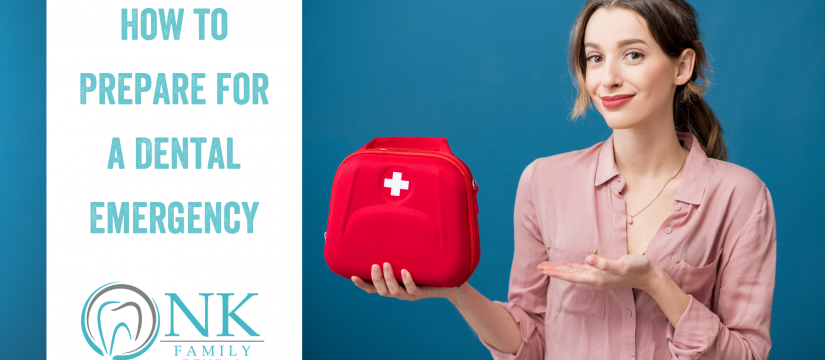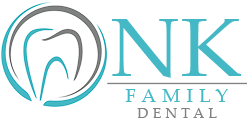
While there’s no way to anticipate when or how a dental emergency will happen, there are thankfully many ways you can be prepared to get a quick handle on the situation. Knowing the steps to take and having the right resources at your disposal can help minimize the effects and severity of a dental emergency. Broken teeth, sudden tooth loss, severe dental pain, signs of an oral infection and more are all potential signs of dental emergencies.
We’ve previously covered what exactly is a dental emergency and what to do in a dental emergency in our NK Family Dental blog. So today, we’re helping you get prepared for the hopefully rare circumstance of experiencing one!
Keep reading to learn more — and contact us at NK Family Dental immediately if you are in need of dental emergency services near Logan Square, Bucktown, Humboldt Park or Wicker Park neighborhoods in Chicago, IL.
Packing Your Emergency Kit
Because no two emergencies are alike, it’s important to have as many possibilities covered when preparing for a dental emergency. That starts with putting a dental emergency kit together that you can easily access at any time. It’s a simple checklist, but it can make a world of difference between the time an emergency occurs and the time you can see your dentist.
Here are some of the most important items to include in your dental emergency kit:
- Your dentist’s contact information
- Sterile gauze
- Toothpaste
- Floss
- Toothbrush
- Save-A-Tooth (emergency tooth preservation product)
- Tylenol (Not aspirin — This can increase bleeding)
Keep these items in an easily accessible and clearly labeled bag or container in your home, car, or with you when traveling. When traveling, you might also want to include a written URL of the ADA’s Find-a-Dentist tool. Consider even keeping a few emergency dental kits around just like you would a first-aid kit! You can never be too prepared, after all.
The Do’s and Don’ts of Dental Emergencies
So, you know what immediate items you’ll need on hand in the event of an emergency, but do you know what you should actually do once one occurs? Familiarizing yourself with what you should and shouldn’t do in a dental emergency ensures that you’re not only materially prepared, but mentally prepared, as well.
Let’s look at the “Do’s and Don’ts” of dental emergencies, with some guidance from Ask the Dentist and Harvard Health Publishing:
Toothache
- Do — Take an over-the-counter pain reliever, rinse out your mouth with warm water, use ice in the affected area and floss to remove any food debris.
- Don’t — Apply pain relievers such as aspirin directly on the irritated tooth/gum area, or apply heat or eat irritating foods (very cold, hot, spicy or sweet).
Facial Swelling
- Do — See a dentist immediately (especially if other signs of infection are present), keep yourself upright (even if sleeping) and drink plenty of water/fluids to stay hydrated in the event of an infection.
- Don’t — Delay seeing a dentist and/or doctor, lie down flat or neglect to stay hydrated.
Broken or Chipped Tooth
- Do — Collect all the fragmented pieces, rinse out your mouth with warm water, stick chewing gum or dental wax on top of the remaining tooth, take an over-the-counter pain reliever if needed and contact your dentist.
- Don’t — Eat hard candy or foods, and don’t attempt to glue the tooth or broken pieces back together.
Knocked-Out or Lost Tooth
- Do — Pick up/touch the tooth by the crown (top) only, rinse off any blood/dirt with milk (preferred) or cold running water, gently place the tooth back in the socket if possible (if not, in cold milk or wrapped in a damp cloth can work), and get to your dentist as soon as you absolutely can.
- Don’t — Touch or scrub the root of the lost tooth.
Pain When Biting or Chewing
- Do — Contact your dentist to explain the pain you feel when biting or chewing, then schedule an appointment to see your dentist soon.
- Don’t — Bite or chew on the affected tooth or area of the mouth, especially for hard foods and candies.
Bleeding Gums
- Do — Rinse out your mouth with warm salt water, maintain proper oral hygiene with brushing and flossing, use a toothbrush with rubber gum massagers or a tip stimulator, and see your dentist for regular cleanings.
- Don’t — Stop brushing your teeth or decrease your oral hygiene activities, as this can increase the condition of gum disease leading to periodontal disease and potentially tooth loss.
Gum Abscess
- Do — Brush and floss like normal and set up an appointment with your dentist for the next day.
- Don’t — Try to pop the abscess.
Pulpal (Inner Tooth) Abscess
- Do — Talk to your dentist as soon as symptoms of temperature sensitivity, irritation when biting or chewing, or random periods of pain from a tooth occur.
- Don’t — Put off seeing your dentist and possibly endodontist, as you could require root canal treatment to prevent tooth loss.
Bleeding After a Dental Procedure
- Do — Keep your head elevated, apply pressure to the bleeding area with clean gauze for five minutes at a time, try pressing a damp tea bag to the cut for up to five minutes, call your dentist if the bleeding does not stop after applying pressure, contact an oral surgeon, or visit the emergency room if there is significant bleeding and if your dentist can’t be reached.
- Don’t — Rinse out your mouth, lie down or wait to seek medical assistance.
Lost or Broken Crown or Filling
- Do — Save the crown or filling, protect the exposed tooth with dental wax, temporarily reattach a crown with denture adhesive and schedule an appointment with your dentist as soon as possible.
- Don’t — Eat either very cold or very hot foods/drinks, and don’t force the filling back into place on your own if it won’t easily go back in.
Broken Dental Appliances
- Do — Save the broken pieces (including dental implants, dentures and bridges), use dental wax to cover any protruding pieces or damaged teeth, and keep dentures removed until you see your dentist, and schedule an appointment ASAP.
- Don’t — Glue any pieces back together, bend any wire clasps or wrap appliance pieces up in tissue.
What About the Emergency Room?
In most cases, your dentist will be able to care for your dental emergencies. However, you should also know the few instances where it might be better to go to the emergency room at the hospital instead. Emergency rooms are not equipped to provide dental treatment, but they can provide emergency pain relief and treatment for health concerns outside the realm of the teeth and gums.
Consider going to the emergency room if you have experienced trauma to the head or jaw, if you are experiencing signs of severe infection (fever, facial swelling, throbbing toothache, tooth sensitivity, inflammation and oral abscesses), or if you have excessive bleeding from the mouth. Even if you choose to go to the ER, call or have someone with you call your dentist to inform them of the dental emergency, as your dentist may still be able to assist in the situation.
Chicago Dental Emergency Services
Dental emergencies can be a stressful time, but the best way to minimize that stress is to be prepared. We hope you will keep this guide handy in your dental emergency preparedness kit to save you some anxiety and to increase the chances of easy recovery.
If you are experiencing a dental emergency near Logan Square, Bucktown, Wicker Park or Humboldt Park in Chicago, NK Family Dental is here for you. See our emergency dental exam page for information on scheduling an emergency appointment, and contact us directly with any questions or concerns you may have.
For our regular dental services such as dental implants, root canal treatment and more, schedule an appointment with NK Family Dental through ZocDoc!
